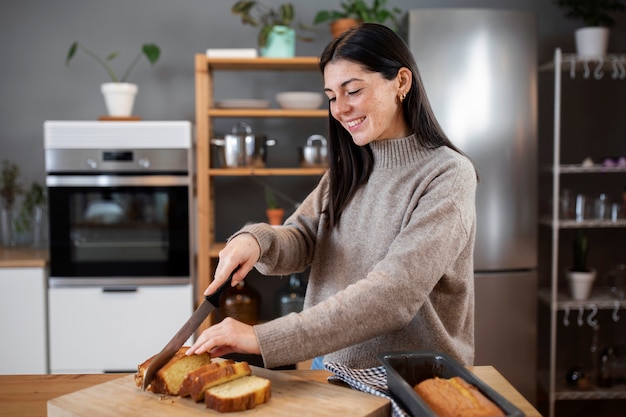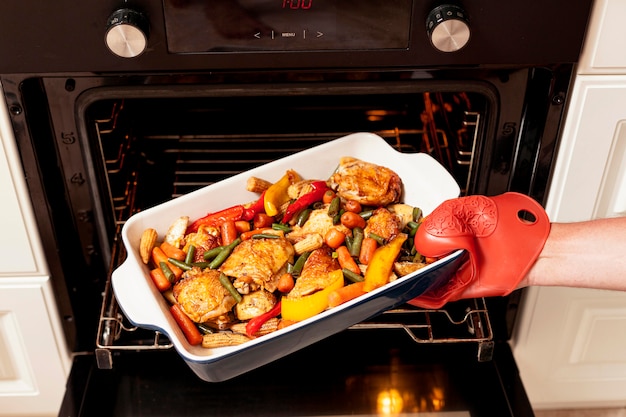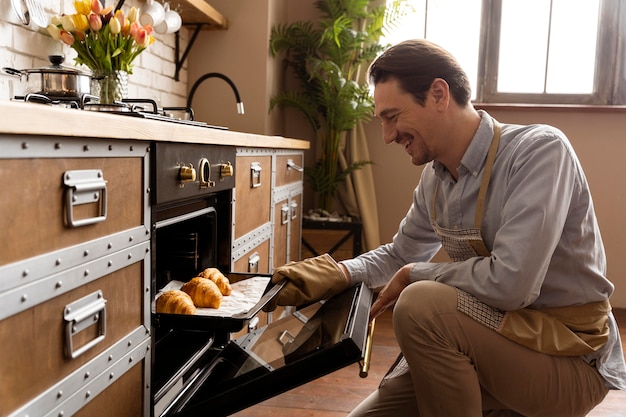The Ultimate Guide to Oven-Roasted Perfection: A Step-by-Step Recipe for Juicy, Flavorful Roasts
Let's face it, there's nothing quite like a perfectly roasted piece of meat. The aroma that fills your home as it cooks, the satisfying crackle of the skin, the tender, juicy meat that melts in your mouth… it's pure culinary bliss. But for many home cooks, achieving that coveted "restaurant-quality" roast seems like a distant dream. The fear of overcooking, dryness, or just plain blandness often keeps us from even attempting it.
But fear not! Over the years, I've learned a thing or two about roasting, and let me tell you, it's not as complicated as it seems. With a little knowledge and some practice, anyone can create a roast that will wow even the pickiest of eaters. Today, I'm going to share my secrets to oven-roasted perfection, and you'll be surprised how simple it really is.
(Part 1) choosing the right cut: The Foundation of Flavor

The first step to a successful roast is choosing the right cut of meat. It's like building a house; you need a solid foundation to support everything else. And in this case, that foundation is the meat itself. We want a cut that's naturally tender and flavorful, one that's going to hold up beautifully in the oven.
Here's the thing: not all cuts are created equal. A thin steak, for example, is going to dry out quickly in the oven. Instead, we want cuts that have a good amount of fat marbling – that's what keeps the meat juicy and flavorful. It's like the internal lubrication for the cooking process, preventing dryness and adding richness.
Best Cuts for Roasting: Your Culinary Powerhouse
Here are some of my favorite cuts for roasting, each offering a unique flavor profile and texture:
- Beef:
- prime rib: The king of roasts, Prime Rib boasts exceptional marbling, making it incredibly juicy and flavorful. It's perfect for special occasions or a luxurious weekend dinner.
- ribeye roast: A close runner-up to Prime Rib, Ribeye Roast is also known for its generous marbling and rich, buttery flavor.
- chuck roast: A more budget-friendly option, Chuck Roast is a tougher cut, but it becomes incredibly tender when slow-roasted, perfect for pulling apart or serving with gravy.
- sirloin roast: A leaner cut than Prime Rib or Ribeye, Sirloin Roast is still flavorful and suitable for roasting. It might need a little extra attention to prevent dryness, but it's worth it for its tender texture.
- Pork:
- pork loin: A versatile cut, Pork Loin is lean and tender, making it perfect for roasting and slicing into individual portions.
- pork shoulder: Known for its rich flavor and tenderness after slow roasting, Pork Shoulder is perfect for pulling apart and creating delicious sandwiches or tacos.
- pork tenderloin: A smaller, more delicate cut, Pork Tenderloin cooks quickly and is best roasted for a short period. Its mild flavor pairs well with a variety of seasonings.
- Lamb:
- Leg of Lamb: A classic roast, Leg of Lamb is flavorful and tender, perfect for a special occasion or a festive gathering.
- Shoulder of Lamb: This cut is rich in flavor and often features a bone-in piece, making it perfect for slow roasting. It's incredibly flavorful and perfect for carving at the table.
- Chicken:
- whole chicken: A classic roast option, Whole Chicken is versatile and flavorful, perfect for a weeknight dinner or a family gathering.
- chicken breast: A leaner cut, Chicken Breast is perfect for roasting and serving with a variety of side dishes.
- cornish hens: Smaller than a whole chicken, Cornish Hens cook quickly and are perfect for a romantic dinner or a cozy meal for two.
(Part 2) Prepping for Perfection: The Art of Seasoning and Beyond

Now that you've chosen your culinary superstar, it's time to get it ready for its starring role in the oven. This is where we add those crucial layers of flavor that will transform your roast from good to absolutely incredible.
Seasoning: The Flavor Symphony
Seasoning is the key to a flavorful roast. Think of it as the symphony of flavor that comes together to create a masterpiece. It's not about overpowering the meat with a million different spices, but rather highlighting its natural flavors with a few simple, well-chosen ingredients.
My go-to seasoning recipe is simple, but incredibly effective:
- Salt: The most important ingredient! Salt draws out the moisture and flavor of the meat, resulting in a juicier, more flavorful roast. Don't be shy; use a generous amount.
- Freshly Ground Black Pepper: A classic pairing with salt, black pepper adds a bit of heat and depth of flavor.
- Dried Herbs: My favorite herbs for roasting are rosemary, thyme, and oregano. They add a touch of earthy flavor and aroma.
- Garlic Powder: This is optional, but a sprinkle of garlic powder can add a nice depth of flavor to the roast.
Pat the meat dry with paper towels before seasoning. This helps the seasoning adhere better and prevents the meat from steaming instead of browning. Then, rub the salt and pepper all over the meat, making sure to coat it evenly. Next, add your chosen herbs and garlic powder, rubbing them in gently.
Optional Steps for Extra Flavor: Elevate Your Roast
For an extra layer of flavor, here are a few optional steps you can take:
- Olive Oil Rub: A light coating of olive oil helps to create a beautiful, crispy skin and enhances the flavor of the meat. It also helps the seasonings adhere better.
- Marinades: Marinating your meat is a great way to infuse it with flavor. Create a mixture of herbs, spices, and acid (like lemon juice or vinegar) and let the meat soak for at least 30 minutes or even overnight.
- Searing: Searing the meat before roasting creates a delicious, flavorful crust and helps lock in the juices. Use a hot pan or a stovetop grill to sear the meat on all sides.
(Part 3) Setting the Stage: Oven Essentials for Roasting Success

Your meat is seasoned and prepped, now it's time to set the stage for the oven-roasting performance. The oven plays a crucial role in creating a perfectly cooked roast, so let's make sure it's ready to shine!
Preheating: The Importance of Getting Started Right
Preheating the oven is a non-negotiable step. Just like a stage needs to be prepped before the actors can perform, the oven needs to be at the right temperature before the meat goes in. This ensures that the roast cooks evenly and doesn't get stuck in the "warm-up" phase for too long.
Oven Rack Position: Finding the Sweet Spot
The position of your oven rack is important for ensuring even heat distribution around the roast. The general rule of thumb is to place the rack in the lower middle position of the oven. This ensures that the heat circulates evenly around the meat, promoting consistent cooking and preventing uneven browning.
(Part 4) The Roasting Performance: Timing and Temperature
It's showtime! We've prepped the stage, now it's time for the main event: the roasting process itself. The key to a juicy, flavorful roast is to cook it slowly and at the right temperature. This allows the meat to cook evenly and prevents it from drying out.
Temperature and Time: Finding the Perfect Balance
The temperature and cooking time will vary depending on the cut of meat you're roasting. But in general, you'll want to roast at a lower temperature (around 325 degrees Fahrenheit or 165 degrees Celsius) for a longer period of time. This allows the meat to cook through evenly and retain moisture.
Here's a general guide for roasting times, but remember, always check the internal temperature of the meat to ensure it's cooked through:
| Meat | Temperature | Time |
|---|---|---|
| Beef | 325°F (165°C) | 15-20 minutes per pound |
| Pork | 325°F (165°C) | 15-20 minutes per pound |
| Lamb | 325°F (165°C) | 15-20 minutes per pound |
| Chicken | 350°F (175°C) | 15-20 minutes per pound |
Monitoring the Meat: The Temperature Check
While your roast is in the oven, don't forget to keep an eye on it. A meat thermometer is your best friend in this process. Use it to check the internal temperature of the meat and ensure it's cooked to the correct level. The exact temperature you're aiming for will depend on the type of meat and your desired level of doneness.
For example, beef should reach an internal temperature of 145°F for medium-rare, while chicken should reach 165°F. These temperatures are crucial for food safety and ensure that the meat is cooked through.
(Part 5) Resting: The Final Act for Juicy Perfection
The roast is cooked, the aroma is intoxicating, but don't rush to carve it just yet. This is where a little patience pays off. Letting the meat rest before carving is crucial for maximizing its juiciness and tenderness.
Think of it like this: when you cook a roast, the juices get pushed to the outside. During the resting phase, these juices have a chance to redistribute back into the meat, making it more evenly moist and flavorful.
A general rule of thumb is to let the meat rest for at least 15 minutes before carving. Cover it loosely with aluminum foil to keep it warm and prevent it from drying out.
(Part 6) The Grand Finale: Serving Your Roasted Masterpiece
After all that anticipation, it's finally time to enjoy the fruits of your labor. This is the moment you've been waiting for: the grand finale, the culmination of all your hard work.
Carving: Revealing the Beauty Inside
Slice the meat thinly across the grain for the most tender and succulent experience. This helps to separate the muscle fibers, making it easier to chew and allowing the flavors to bloom.
Side Dishes: Completing the Culinary Symphony
A delicious roast deserves a supporting cast of flavorful side dishes. Consider a medley of roasted vegetables, creamy mashed potatoes, a vibrant green salad, or a simple, but elegant rice pilaf. Each element adds its own unique melody to the overall symphony of flavors.
Sauce: Elevating the Experience
For an extra layer of richness and flavor, consider making a pan sauce. Deglaze the roasting pan with some wine or broth, scraping up the flavorful bits that have stuck to the bottom. Simmer until the sauce thickens, creating a savory accompaniment that elevates the entire meal.
(Part 7) Avoiding Common Pitfalls: Mastering the Roasting Game
Even the most experienced cooks make mistakes. But understanding common pitfalls can help us avoid them, ensuring a delicious and successful roast every time. Here are a few things to keep in mind:
Overcrowding the Pan: Giving the Meat Room to Breathe
Don't cram your roast into a tiny pan. Give it enough space to breathe and cook evenly. If you're working with a large roast, consider using two pans instead of one. This will ensure that the heat reaches all sides of the meat and helps create a more evenly browned exterior.
Neglecting the Temperature: Trust the Thermometer
Always, always, always check the internal temperature of the meat using a meat thermometer. This is the only way to know for sure if it's cooked to the correct level, especially for poultry and pork, where food safety is paramount. Don't rely on guessing, let the thermometer guide your decision.
Rushing the Resting Period: Patience is a Virtue
Resist the urge to carve into the roast immediately after it comes out of the oven. Let it rest for at least 15 minutes. This allows the juices to redistribute back into the meat, creating a juicier and more flavorful outcome.
Overdoing it: Don't Overcook
It's easy to overcook a roast, especially if you're not paying close attention. Remember, it's always better to err on the side of slightly undercooked than overcooked. Overcooked meat becomes dry and tough, which is the opposite of what we're aiming for.
(Part 8) FAQs: Your Roasting Questions Answered
Here are some frequently asked questions about oven roasting, along with detailed answers to help you master the art of roasted perfection:
1. What is the best way to prevent a roast from drying out?
The key to preventing dryness is to cook the roast slowly at a lower temperature. This allows the meat to cook through evenly without becoming tough or dry. Another trick is to cover the roast with aluminum foil during the cooking process, especially for leaner cuts, to help trap moisture.
2. How do I know when a roast is cooked through?
The most reliable way to determine if a roast is cooked through is to use a meat thermometer. Insert the thermometer into the thickest part of the meat, making sure it's not touching any bone. The exact internal temperature you're aiming for will depend on the type of meat and your preferred level of doneness. Always consult a reliable source for recommended temperatures.
3. How can I make a crispy skin on a roast?
To achieve a crispy skin, consider searing the roast before putting it in the oven. This creates a flavorful crust and helps lock in the juices. Additionally, rubbing the meat with a little olive oil before seasoning can help create a more crispy skin.
4. Can I use a marinade on a roast?
Absolutely! Marinades are a fantastic way to infuse your roast with extra flavor and moisture. Create a flavorful blend of herbs, spices, and a touch of acid (like lemon juice or vinegar) and let the meat soak for at least 30 minutes or, even better, overnight.
5. What should I do if my roast is overcooked?
If your roast is overcooked, don't despair! It's not the end of the world. Slice the meat thinly and serve it with a flavorful pan sauce or gravy. The sauce will help to compensate for any dryness and add a layer of richness to the dish. You can also try adding a little extra moisture by topping the roast with a flavorful broth or wine reduction.
With a little practice and attention to detail, you can become a master of oven roasting. Don't be afraid to experiment, try different cuts, and explore new flavor combinations. Soon, you'll be creating delicious roasts that will have your friends and family begging for seconds (and maybe even thirds!). Happy roasting!
Everyone is watching

Prime Rib Roast Cooking Time Chart: Per Pound Guide
Cooking TipsPrime rib roast. Just the name conjures images of lavish dinners, crackling fires, and hearty laughter. It’s ...

How Long to Bake Potatoes in the Oven (Perfect Every Time)
Cooking TipsBaked potatoes are a staple in my kitchen. They're incredibly versatile, delicious, and surprisingly easy to m...

Perfect Rice Every Time: The Ultimate Guide to Cooking Rice
Cooking TipsAs a self-proclaimed foodie, I've always been a bit obsessed with rice. It's the foundation of countless cuisi...

The Ultimate Guide to Cooking Asparagus: Tips, Techniques, and Recipes
Cooking TipsAsparagus. The mere mention of this spring delicacy conjures up images of vibrant green spears, crisp and burs...

Ultimate Guide to Cooking the Perfect Thanksgiving Turkey
Cooking TipsThanksgiving. Just the word conjures up images of overflowing tables laden with delicious food, the scent of r...
